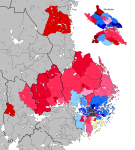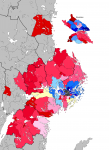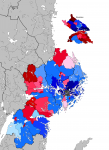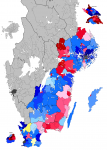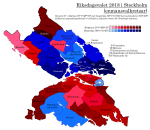Gothenburg
Quota (for all of Västra Götaland County): 21,428
Number of constituencies: 22 (counting everything on the map - the Partille seat includes no territory inside Gothenburg municipality, so in practice it's fairer to say the number is 21)
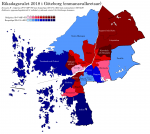 Part One: Inner City
Part One: Inner City
208: Göteborg Centrum (Gothenburg Centre)
Electorate: 20,003 (-1,425)
As the name implies, this seat includes most of Gothenburg's city centre - its population is concentrated in the south and east of the seat, in Stampen, Heden and around Kungsportsavenyn. Avenyn (as it's almost always known), along with intersecting Vasagatan, is the city's traditional millionaires' row, and even though Heden and Stampen are more typical mixed inner-city neighbourhoods, this still leaves the constituency solidly blue.
Moderate: 4,743 (28.7%)
Social Democratic: 2,759 (16.7%)
Sweden Democrats: 2,199 (13.3%)
Alliance: 8,685 (52.6%)
Red-Greens: 5,435 (32.9%)
Right Opposition: 7,941 (48.1%)
January Bloc: 6,688 (40.5%)
209: Johanneberg
Electorate: 24,857 (+3,429)
This seat, which is getting dangerously large at this point (though it's somehow only the second biggest in the city), covers the southern half of the
Centrum borough, and is centred on the campus of Chalmers University of Technology. Students, both of Chalmers and the University of Gothenburg, form a significant demographic here, but the seat also includes plenty of regular rental housing as well as a few detached houses along the city line in Krokslätt. While very diverse, it's prosperous enough to deliver a small blue majority in all scenarios but C.
Moderate: 4,486 (21.5%)
Social Democratic: 3,759 (18.0%)
Left: 2,895 (13.8%)
Alliance: 9,671 (46.2%)
Red-Greens: 8,777 (42.0%)
January Bloc: 9,683 (46.3%)
Right Opposition: 7,760 (37.1%)
210: Haga och Slottsskogen
Electorate: 19,890 (-1,538)
Haga, once a run-down working-class neighbourhood with dilapidated houses, little government presence and a strong Communist bent (usually not the electoralist kind), has latterly become a symbol of Gothenburg's gentrification. Rather than being torn down as elsewhere, the area's characteristic wooden houses have been renovated and now sell for millions, several being home to boutique shops and cafés where tourists can come and eat dinner-plate-sized cinnamon rolls. To its south, the area around Linnéplatsen is a typical middle-class inner-city neighbourhood whose inhabitants mostly vote blue, and they're a far bigger part of the electorate than the couple of thousand people who still live in Haga, so the seat goes their way and ends up similar-ish to Johanneberg.
Moderate: 3,708 (22.3%)
Social Democratic: 3,035 (18.2%)
Left: 2,489 (14.9%)
Alliance: 7,560 (45.4%)
Red-Greens: 7,152 (42.9%)
January Bloc: 7,477 (44.9%)
Right Opposition: 6,309 (37.9%)
211: Masthugget
Electorate: 21,122 (-306)
I have no reliable way of checking (yet - watch this space), but I have a strong suspicion Masthugget is the smallest constituency by land area in Sweden. This is the heart of working-class Gothenburg - Andra Långgatan is packed with dive bars (though not as many as in the 80s, when it was practically a Shinjuku Golden Gai situation), Järntorget is where the city's May Day celebrations traditionally take place, and the KPML(r) was based in the charmingly-named Marx-Engels House at the neighbourhood's south end throughout its golden age. Predictably, it's quite a left-leaning seat - in 2014, the Moderates won it in scenario A thanks to the very divided left, but in 2018 the Left Party takes the seat on a strong swing from both the Greens, the Social Democrats and FI. It's reliably left-wing in both other scenarios, although slightly less so in scenario C due to the Left being removed from the red bloc.
Left: 4,497 (25.0%)
Social Democratic: 3,470 (19.3%)
Moderate: 2,821 (15.7%)
Red-Greens: 10,108 (56.2%)
Alliance: 6,102 (34.0%)
January Bloc: 8,010 (44.6%)
Right Opposition: 5,015 (27.9%)
212: Majorna
Electorate: 19,402 (-2,026)
No one knows where Majorna got its name - there's a persistent rumour that it comes from the word
mög, meaning manure, as it was home to the refuse dump for nearby Älvsborg Fortress, but the more likely option is that it comes from a Finnish or Estonian word meaning a shack or cottage. Either way, you can guess from those theories that this is not a wealthy area - historically, it was mainly populated by sailors, dockers and menial labourers who couldn't afford to live anywhere else. It wasn't annexed into Gothenburg proper until the 1860s, and even then it remained a firmly working-class area for over a century afterwards. It's really only in recent years that gentrification has begun to hit it, and it remains diverse and bohemian enough to make it a solidly red seat. In 2014, this was the Left's only seat in scenario A, and they hold it in 2018.
Left: 4,997 (30.8%)
Social Democratic: 3,394 (20.9%)
Green: 1,729 (10.6%)
Red-Greens: 10,408 (64.1%)
Alliance: 4,010 (24.7%)
January Bloc: 6,884 (42.4%)
Right Opposition: 3,855 (23.7%)
